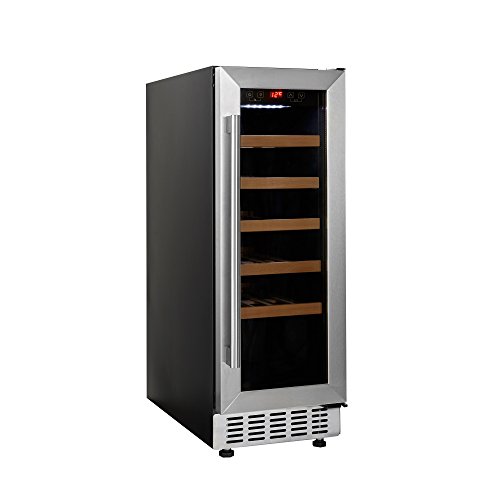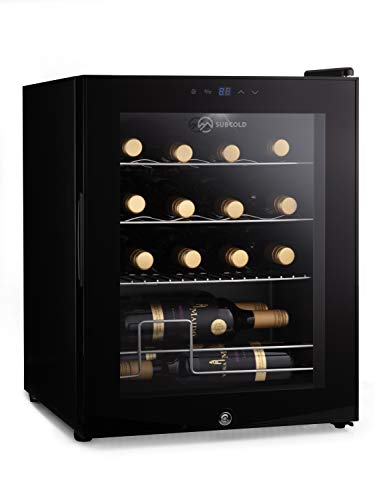You'll Never Be Able To Figure Out This Wine Fridge Cooler's Tricks
페이지 정보
작성자 Derek 작성일24-11-06 00:59 조회3회 댓글0건관련링크
본문
 The Benefits of a Wine Fridge Cooler
The Benefits of a Wine Fridge CoolerA wine fridge cooler helps keep bottles at the perfect temperature for aging and achieving their full potential. A good wine refrigerator also controls humidity levels in order to prevent corks drying out and oxidizing.
Choose a wine refrigerator with multiple temperature zones. This is a great feature when you have different kinds of wine that have different needs for storage.
Compressor-based cooling
Wine fridge coolers make use of compressor technology to keep your favorite wines at an ideal temperature for serving or long-term storage. This kind of cooling system is more often found in beverage refrigerators and offers a more consistent temperature across the inside of the refrigerator, making it an ideal choice for top rated wine fridge storage.
Freestanding or built-in wine fridges that use this cooling technology can be affixed to your bar, kitchen, wine cellar, or closet. They can be installed undercounter or recessed, and in a lot of cases come with front-facing ventilation, so that they be seamlessly integrated with the other kitchen appliances.
Wine refrigerators that utilize this cooling technology don't just maintain the correct temperature but also perform other functions essential for storing wines. For instance, they can be equipped with a humidity control system that checks the air inside the refrigerator and adjusts the water flow to ensure the wine bottles are properly humidified. This prevents oxidation, which can alter the flavor of the wine and beverage fridge.
Certain wine coolers also come with triple or dual temperature zones so that you can keep different kinds of wine at the right temperature. This is an excellent option for those who serve both white and red wines or who want their wine collection divided into various categories of storage.
Some wine refrigerators employ this type of cooling to provide an UV-resistant door that shields the wine from harmful ultraviolet radiation.
In addition to their capability to cool wine to the right temperature, wine refrigerators that use this technology are generally quiet and produce no vibrations. They don't use liquid refrigeration and thus do not have moving parts that oscillate or cycle while operating. This helps reduce vibrations that can cause loose hardware connections and other issues with the internal parts of the wine refrigerator cooler. This helps reduce the noise and keeps your wine tasting great.
Thermoelectric Cooling
Thermoelectric coolers are a distinct technology from compressor-based units. Instead of refrigerants, thermoelectric coolers rely on the Peltier effect to keep wine bottles cool. The Peltier effect occurs when an electrical current is passed through two metal pieces that are connected and causes one side to heat up while the other cools down. This temperature difference allows the cooler to keep the cabinet cool.
In the majority of cases, the cooler will utilize an air source to distribute cold air across the interior of the cabinet. This is usually a piece of aluminium that has been electrolyzed to increase its surface area and assist in dispersing heat. The cooling process is aided by fans positioned on each side of the heat sink to aid in circulation and ensure the wine stays at a constant temperature.
The main benefit of this technology is that it is environmental friendly. Thermoelectric coolers are environmentally friendly because they don't utilize refrigerants. They also consume far less energy and are usually less expensive to operate than their compressor-based counterparts.
It is important to remember that compressor units are more effective at keeping commercial wine refrigerator bottles at the optimal temperature than thermoelectric wine coolers. They are not able to reach the required temperature. They also require more maintenance since they are always running.
In addition to their energy-efficient and eco-friendly capabilities, thermoelectric narrow wine fridge refrigerators are also quiet. This makes them a great option for people who reside in homes or restaurants where it is essential to maintain the ambience of the space. They are ideal for living rooms where guests entertain guests or like to enjoy an alcoholic drink on their own. This is because they can be put in any room in the home or restaurant without causing disturbance. This is because they don't rely on any motors or compressors that can be noisy.
Humidity Control
Wine is sensitive to environment and requires specific conditions to properly age. Temperature and humidity are essential in this process to preserve cork integrity and quality over time. A wine fridge keeps an optimal temperature range and regulates humidity to ensure the perfect ageing process.
The ideal level of humidity for wine storage is between 50 and 70%. If the humidity drops there is a chance of oxidization that can develop off-flavors, which can cause the wine to lose its taste. In addition, excessive humidity creates an ideal environment for the growth of mildew and mold that can cause damage to labels and affect the quality of the cork. Wine fridges create an environment that hinders the growth of mold and mildew which protects the appearance and flavor of wine.
Many wine refrigerators come with humidity control systems to control and maintain the proper humidity levels. These systems are equipped with an inbuilt humidity control system that monitors and adjusts humidity settings automatically in order to maintain the desired range.
Some wine refrigerators have internal fans that circulate air and stop pockets from creating. This helps maintain constant conditions throughout the wine storage space and helps reduce energy consumption by limiting fluctuations in temperature.
In addition, many wine fridges come with doors made of solid or dual-paned which provide insulation and protection from harmful UV rays that can destroy the wine's components and alter the taste. Certain wine refrigerators are equipped with vibration-reduction systems to limit disturbances that can disturb sediments in older bottles or disturb the aging process.
If your wine refrigerator has been operating in insufficient conditions for an extended period of time, you might need to add more moisture. Air dehumidifiers, moisture absorbers made of crystals or mineral salts can be used as short-term solutions to suck up water vapour from the air. They should be emptied and replaced frequently. If you want a permanent solution, install an active air humidification system that combines an atomizer for water and a water tank.
Capacity of Storage
A wine fridge is an asset if like wine frequently and wish to have a few bottles available for unplanned or spontaneous occasions. These devices recreate the ideal conditions found in natural cellars and caves, so that your wines can develop their full flavor over time.
Wine is a complex mix of substances that interact to create distinct flavors and smells. The right storage conditions will preserve these qualities, and will prevent premature aging. This will deprive the wine of its true essence. In a standard refrigerator fluctuations in temperature can damage these molecules and cause flavors to fade. In a wine refrigerator humidity control and constant temperatures prevent these problems.
In addition to ensuring optimal temperatures, wine refrigerators also regulate humidity levels to prevent corks from drying out and leaking. If the wine bottle is kept in a dry area, it's possible that the labels will peel off. The wine may also lose its flavor. Wine fridges keep relative humidity levels that range between 55% and 75 % to protect the integrity and taste of the wine bottles.
These cooling systems are often equipped with internal fans that provide uniform air flow throughout the cabinet. This eliminates pockets or warm or humid air, and ensures that the collection is at an even temperature. A lot of units have shelves and racks designed to softly and securely hold bottles. This helps protect the bottles from damage and also allows you to organize your collection in a way that is efficient.
Some wine refrigerators feature dual temperature zones which are useful for storing various types of wine at their optimal temperatures. These devices also have LED lighting and doors that are UV-resistant. These features block harmful sunlight from reaching your wine and make them easy to find. Certain wine fridges also come with carbon filters that help to reduce the odors that emanate from the air, which can seep into the corks, affecting the flavor of the wine.
 Think about the size of your wine collection and the space you need to store it when you shop for fridges. Wine coolers are available in a variety of sizes and shapes, and can be placed under cabinets or counters. Some models have venting on the front, so they can be installed in narrower spaces. Some wine refrigerators come with shelves that can be adjusted to let you store bottles in any shape.
Think about the size of your wine collection and the space you need to store it when you shop for fridges. Wine coolers are available in a variety of sizes and shapes, and can be placed under cabinets or counters. Some models have venting on the front, so they can be installed in narrower spaces. Some wine refrigerators come with shelves that can be adjusted to let you store bottles in any shape.댓글목록
등록된 댓글이 없습니다.

